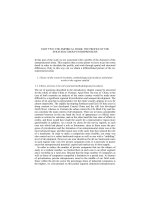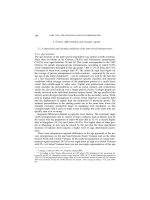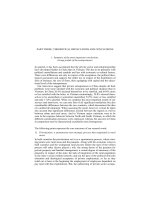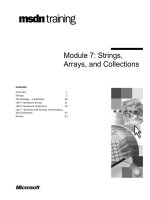Tài liệu Lecture Notes in Geoinformation and Cartography pdf
Bạn đang xem bản rút gọn của tài liệu. Xem và tải ngay bản đầy đủ của tài liệu tại đây (6.94 MB, 317 trang )
Lecture Notes in Geoinformation and Cartography
Series Editors: William Cartwright, Georg Gartner, Liqiu Meng,
Michael P. Peterson
Poh C. Lai • Ann S.H. Mak
(Eds.)
GIS for Health and
the Environment
Development in the
Asia-Pacific Region
With 110 Figures
Editors:
Poh C. Lai
Department of Geography
The University of Hong Kong
Hong Kong Special Administrative
Region, China
Ann S.H. Mak
ERM Hong Kong
Taikoo Place, Island East
Hong Kong Special Administrative
Region, China
ISBN 10 3-540-71317-4 Springer Berlin Heidelberg New York
ISBN 13 978-3-540-71317-3 Springer Berlin Heidelberg New York
ISSN 1863-2246
Library of Congress Control Number: 2007929856
This work is subject to copyright. All rights are reserved, whether the whole or part of the
material is concerned, specifically the rights of translation, reprinting, reuse of illustra-
tions, recitation, broadcasting, reproduction on microfilm or in any other way, and stor-
age in data banks. Duplication of this publication or parts thereof is permitted only under
the provisions of the German Copyright Law of September 9, 1965, in its current version,
and permission for use must always be obtained from Springer-Verlag. Violations are li-
able to prosecution under the German Copyright Law.
Springer is a part of Springer Science+Business Media
springeronline.com
© Springer-Verlag Berlin Heidelberg 2007
The use of general descriptive names, registered names, trademarks, etc. in this publica-
tion does not imply, even in the absence of a specific statement, that such names are ex-
empt from the relevant protective laws and regulations and therefore free for general use.
Cover design: deblik, Berlin
Production: A. Oelschläger
Typesetting: Camera-ready by the Editors
Printed on acid-free paper 30/2132/AO 54321
This publication is printed with funding support from:
ଉܑཽ۩ਙਙࢌՠ֗ઝݾݝʳ
COMMERCE, INDUSTRY AND TECHNOLOGY BUREAU
THE GOVERNMENT OF THE HONG KONG
SPECIAL ADMINISTRATIVE REGION
Disclaimer:
Any opinions, findings, conclusions or recommendations expressed in this material / any
event organized under this Project do not reflect the views of the Government of the Hong
Kong Special Administrative Region or the Vetting Committee for the Professional Ser-
vices Development Assistance Scheme.
ڇڼעढՂ˂ٚ۶ऱႈؾ೯փ।ሒऱٚ۶რߠΕઔߒګ࣠Εᓵࢨ৬
ᤜΔࠀլז।ଉܑཽ۩ਙਙࢌ֗റᄐࣚ೭࿇୶ᇷܗૠቤေᐉࡡᄎ
ऱᨠរΖʳ
V
Preface
“As the world becomes more integrated through the trade of goods
and services and capital flows, it has become easier for diseases to
spread through states, over borders and across oceans — and to do
serious damage to vulnerable human and animal populations.”
American RadioWorks and NPR News, 2001
The global cost of communicable diseases is expected to rise. SARS has
put the world on alert. We have now Avian Flu on the watch. Recognizing
the global nature of threats posed by new and re-emerging infectious dis-
eases and the fact that many recent occurrences originated in the Asia Pa-
cific regions, there has been an increased interest in learning and knowing
about disease surveillance and monitoring progresses made in these re-
gions. Such knowledge and awareness is necessary to reduce conflict, dis-
comfort, tension and uneasiness in future negotiations and global coopera-
tion.
Many people are talking about the GIS and public and environmental
health. The way we make public policies on health and environmental mat-
ters is changing, and there is little doubt that GIS provides powerful tools
for visualizing and linking data in public health surveillance. This book is
a result of the International Conference in GIS and Health held on 27-29
June 2006 in Hong Kong. The selected chapters are organized into four
themes: GIS Informatics; Human and Environmental Factors; Disease
modeling; and Public health, population health technologies, and surveil-
lance.
As evident from the chapters, the main problem in GIS-based epidemi-
ological studies is the availability of reliable exposure data. There is also a
huge problem of showing adequate responsibility and ability to meet pub-
lic concerns, such as protection on privacy and quick response systems.
There has been some works done in search of the right approach in bring-
ing together and reconciling market and public interests. Talking to each
other and sharing critical information are getting increasingly important.
Much work remains to be done to improve the GIS-based epidemiologic
methods into tools for fully developed analytical studies and, particularly,
the need to identify standard interfaces and infrastructures for the global
disease reporting system.
January 2007 Poh C. Lai
Ann S.H. Mak
VI
International Conference in GIS and Health 2006
Geospatial Research and Application Frontiers in
Environmental and Public Health Systems
1
Conference Chair
Poh C. Lai, University of Hong Kong, China
Program Committee
International Members
Chuleeporn Jiraphongsa, Ministry of Public Health, Thailand
Nina Lam, Louisiana State University, USA
Feng Lu, Chinese Academy of Sciences, China
Augusto Pinto, World Health Organization, France
Jan Rigby, University of Sheffield, United Kingdom
Pratap Singhasivanon, University of Mahidol, Thailand
Chris Skelly, Brunel University, United Kingdom
Local Members
Ping Kwong Au Yeung, Lands Department
Lorraine Chu, Mappa Systems Limited
Tung Fung, Chinese University of Hong Kong
Tai Hing Lam, University of Hong Kong
Hui Lin, Chinese University of Hong Kong
Christopher Hoar, NGIS China Limited
S.V. Lo, Health Welfare and Food Bureau
Ann Mak, ERM Company Limited
Stanley Ng, MapAsia Company Limited
Wenzhong Shi, Hong Kong Polytechnic University
Winnie Tang, ESRI China (Hong Kong) Limited
Raymond Wong, Intergraph Hong Kong
Anthony Gar-On Yeh, University of Hong Kong
Qiming Zhou, Hong Kong Baptist University
Executive Committee
Kawin K.W. Chan, University of Hong Kong
Richard K.H. Kwong, University of Hong Kong
Poh C. Lai, University of Hong Kong
Sharon T.S. Leung, NGIS China Limited
Feng Lu, Chinese Academy of Sciences
Ann S.H. Mak, ERM Company Limited
Franklin F.M. So, Experian Limited
Andrew S.F. Tong, University of Hong Kong
1
The conference was a joint event held in June 2006 and jointly organized by the Department of
Geography at the University of Hong Kong and the State Key Laboratory of Resources and
Environmental Information Systems of the Chinese Academy of Sciences. It was supported by the
Croucher Foundation and the Professional Services Development Assistance Scheme of the
Commerce, Industry and Technology Bureau of the Government of Hong Kong.
VII
Table of Contents
GIS Informatics 3
Exploratory Spatial Analysis Methods in Cancer Prevention and Con-
trol
Gerard Rushton 3
Environmental Risk Factor Diagnosis for Epidemics
Jin-feng Wang 3
A Study on Spatial Decision Support Systems for Epidemic Disease
Prevention Based on ArcGIS
Kun Yang, Shung-yun Peng, Quan-li Xu and Yan-bo Cao 3
Development of a Cross-Domain Web-based GIS Platform to Support
Surveillance and Control of Communicable Diseases
Cheong-wai Tsoi 3
A GIS Application for Modeling Accessibility to Health Care Centers
in Jeddah, Saudi Arabia
Abdulkader Murad 3
Human and Environmental Factors 3
Applying GIS in Physical Activity Research: Community ‘Walkability’
and Walking Behaviors
Ester Cerin, Eva Leslie, Neville Owen and Adrian Bauman 3
Objectively Assessing ‘Walkability’ of Local Communities: Using GIS
to Identify the Relevant Environmental Attributes
Eva Leslie, Ester Cerin, Lorinne duToit, Neville Owen and Adrian
Bauman 3
Developing Habitat-suitability Maps of Invasive Ragweed (Ambrosia
artemisiifolia.L) in China Using GIS and Statistical Methods
Hao Chen, Lijun Chen and Thomas P. Albright 3
An Evaluation of a GIS-aided Garbage Collection Service for the East-
ern District of Tainan City
Jung-hong Hong and Yue-cyuan Deng 3
VIII
A Study of Air Quality Impacts on Upper Respiratory Tract Diseases
Huey-hong Hsieh, Bing-fang Hwang, Shin-jen Cheng and Yu-ming
Wang 3
Spatial Epidemiology of Asthma in Hong Kong
Franklin F.M. So and P.C. Lai 3
Disease Modeling 3
An Alert System for Informing Environmental Risk of Dengue Infec-
tions
Ngai Sze Wong, Chi Yan Law, Man Kwan Lee,
Shui Shan Lee and Hui Lin 3
GIS Initiatives in Improving the Dengue Vector Control
Mandy Y.F. Tang and Cheong-wai Tsoi 3
Socio-Demographic Determinants of Malaria in Highly Infected Rural
Areas: Regional Influential Assessment Using GIS
Devi M. Prashanthi, C.R. Ranganathan and
S. Balasubramanian 3
A Study of Dengue Disease Data by GIS Software in Urban Areas of
Petaling Jaya Selatan
Mokhtar Azizi Mohd Din, Md. Ghazaly Shaaban,
Taib Norlaila and Leman Norariza 3
A Spatial-Temporal Approach to Differentiate Epidemic Risk Patterns
Tzai-hung Wen, Neal H Lin, Katherine Chun-min Lin,
I-chun Fan, Ming-daw Su and Chwan-chuen King 3
Public health, population health technologies, surveillance 3
A “Spatiotemporal Analysis of Heroin Addiction” System for Hong
Kong
Phoebe Tak-ting Pang, Phoebe Lee, Wai-yan Leung,
Shui-shan Lee and Hui Lin 3
A Public Health Care Information System Using GIS and GPS: A Case
Study of Shiggaon
Ashok Hanjagi, Priya Srihari and A.S. Rayamane 3
IX
GIS and Health Information Provision in Post-Tsunami Nanggroe Aceh
Darussalam
Paul Harris and Dylan Shaw 3
Estimating Population Size Using Spatial Analysis Methods
A. Pinto, V. Brown, K.W. Chan, I.F. Chavez,
S. Chupraphawan, R.F. Grais, P.C. Lai, S.H. Mak,
J.E. Rigby and P. Singhasivanon 3
Avian Influenza Outbreaks of Poultry in High Risk Areas of Thailand,
June-December 2005
K. Chanachai, T. Parakgamawongsa, W. Kongkaew, S.
Chotiprasartinthara and C. Jiraphongsa 3
Contact Information and Author Index 298
Subject Index 307
Exploratory Spatial Analysis Methods in Cancer
Prevention and Control
Gerard Rushton
The University of Iowa
Exploratory Spatial Analysis Methods in Cancer Prevention and Control
Abstract: Improved geocoding practices and population coverage of can-
cer incidence records, together with linkages to other administrative record
systems, permit the development of new methods of exploratory spatial
analysis. We illustrate these developments with results from a GIS-based
workbench developed by faculty and students at the University of Iowa.
The system accesses records from the Iowa Cancer Registry. In using these
methods, the privacy of individuals is protected while still permitting re-
sults to be available for small geographic areas. Geographic masking tech-
niques are illustrated as are kernel density estimation methods used in the
context of Monte Carlo simulations of spatial patterns of selected cancer
burdens of breast, colorectal and prostate cancer in Iowa.
Keywords: cancer prevention and control, exploratory spatial analysis
1 The need for maps in cancer prevention and control
The theme of this chapter is the design of cancer maps for cancer control
and prevention activities. Abed et al. (2000) describe a framework for de-
veloping knowledge for making decisions for comprehensive cancer con-
trol and prevention. The decisions these authors have in mind involve local
communities setting objectives, planning strategies, implementing them,
and finally, determining improvements in health achieved by their activi-
ties. Each of these steps is explicitly spatial: where activities are directed,
who is affected, and whose health is improved? Location is a critical part
of this framework.
As with all chronic diseases, factors that influence the burden of the dis-
ease on any population include the behaviors of people, characteristics of
environments, and availability and accessibility of health screenings and
treatments. Objectives to improve population health, therefore, must iden-
Exploratory Spatial Analysis Methods in Cancer Prevention and Control 3
tify spatial differences in these factors and must address strategies to
change them in ways that will lead to improved health outcomes. Cancer
maps play an important role in this process. Particularly geographic as-
pects of these tasks are:
z Spatial allocation of resources;
z Identification of areas with higher than expected incidence rates
(disease clusters);
z Optimal location of services.
All three tasks require that the maps of the cancer burdens should cap-
ture any special demographic characteristics of local populations so that
actions for control and prevention relate to population characteristics.
None of these tasks should use cancer rates adjusted to standard population
characteristics. Yet, these are precisely the characteristics of many cancer
maps—see, for example, Pickle et al. 1996; Devesa et al. 1999.
1.1 The limitations of cancer mortality maps
In the short history of mapping cancer, most attention has been given to
mapping cancer mortality; for most countries, cancer mortality data are
collected routinely.
Since the geocode on a typical death certificate is some politically rec-
ognized area—often, in the United States a county—data is available for
counties and most maps use counties or aggregates of counties, (Devesa et
al. 1999). Mortality maps, however, are not so useful for planning control
and prevention interventions because spatial variations in mortality rates
can be due to differences in behaviors, in the environment or in local
health system characteristics. Yet, untangling risks due to differences in
these three factors is precisely what is required before plans to reduce can-
cer burdens can be established. With the development of cancer registries,
however, data is available that allows attempts to be made to separate these
influences and to develop interventions that will optimally reduce rates.
Cancer maps have a vital role to play by mapping these factors, in addition
to mortality.
1.2 The potential contribution of cancer registry data
There are two ways in which cancer registry data can be used for making
cancer maps. They can be used to break down the burden of cancer on lo-
cal populations into component parts. Assumed here is that the cancer reg-
istry is population-based; i.e. it accounts for all cases of cancer in a defined
population. Although it may rely on health care facilities for much of its
4 Gerard Rushton
data, it must not be facility based. In most cases, registries are area-based
and track down incidences of cancer in its defined population wherever
they are diagnosed and treated. The components of interest are first con-
firmed diagnoses of cancer; the stage of the disease at the time of first di-
agnosis; the first course of treatment, survival rate, and mortality rate.
Other components of cancer are screening rates and treatment rates. Data
availability for these components often depends on the comprehensiveness
of the health information available for the defined population (see Arm-
strong 1992).
1.3 The role of exploratory spatial analysis
In “exploratory spatial analysis” of cancer, geographic scale and pattern
are explored. Each cancer map represents a decision to focus on a defined
geographic scale and specific patterns may be revealed—or concealed—by
the scale chosen. Figure 1 illustrates this principle using three infant mor-
tality maps of one county in central Iowa. Approximately 20,000 births
and 190 infant deaths occurred in this county in the four year period from
1989 through 1992. After geocoding each birth and death to its residential
address, the three maps on the right of Figure 1 show the pattern at the
scales captured by three, commonly used, administrative areas. A property
of these maps is that the variability of the infant mortality rates depends on
the size of the areas mapped. The rate for Zipcodes varies from 0 to 20
deaths per thousand births; for census tracts the rate varies from 0 to 36
and for census block groups the rate varies from 0 to 72. The legends for
each map—not shown here—must necessarily be adjusted to accommo-
date these different variances. The sensitivity of the patterns of infant mor-
tality to scale are clear on the left where geographic scales of the three
maps are formally defined as spatial filters of 1.2, 0.8, and 0.4 miles re-
spectively—applied in each case to a 0.4 mile grid from which the density
estimates were made (see Bithell 1990; Rushton and Lolonis 1996). Again,
on the left, patterns are different and depend on scale. We can conclude
that patterns depend on scale and actions based on patterns should consider
the scales at which the patterns were derived and ask whether the actions
contemplated are reliably based on the data that supported them.
Exploratory Spatial Analysis Methods in Cancer Prevention and Control 5
Fig. 1. Infant mortality rates (deaths per 1000 births) at three different spatial
scales and their approximate counterparts using census administrative areas (leg-
end for maps on the right is not shown)
The ability to control the spatial basis of support for cancer rates is the
key idea that geographic information systems bring to the task of providing
decision support for cancer prevention and control. A key question we ask
is at what geographic scale do significant differences in cancer incidence
rates or other measures of cancer exist in any region of interest? A reason
for asking this question is so that we can decide the scale at which inter-
ventions should be planned. Logical though this question may appear, it
has not been the question that has driven the rather large literature of spa-
tial analysis of cancer. Traditionally, cancer maps were based on pre-
defined political or administrative units for which cancer data was col-
lected. Starting with regions already defined we made maps and then asked
“do we see a pattern.” Such a strategy pre-supposes that spatial variations
that occur within the regions mapped do not exist or, if present, are not
relevant or important. With GIS, however, we start with geocoded data—at
the level of points or small areas—and then we ask “at what geographic
scale do we want to view this pattern?” Thus, it is the much smaller lit-
erature of spatial analysis of cancer based on data manipulated in a GIS
that is the literature most relevant to cancer control and prevention. Cancer
maps for this purpose employ density estimation methods. Unlike tradi-
tional cancer maps that show cancer statistics based on spatial units of dif-
6 Gerard Rushton
ferent sizes, shapes and populations that conceal scale dependent patterns,
density estimation techniques are designed to control the spatial basis of
support for the spatial pattern of any statistic of interest. These are made
possible by developments in the availability of geospatial data, geocoding
techniques, and methods of spatial analysis that allow the opportunity to
control the size, shapes and population characteristics for the spatial units
for which statistics are computed.
1.4 Mapping cancer burdens
The first measure of the cancer burden on a population is the rate of inci-
dence of any particular cancer type adjusted for age and sex of the local
population. The first choice to be made is between direct and indirect rate
adjustment methods. Direct adjustment of rates is made when rates are to
be compared from one area to another to note the rate burden on the popu-
lation. In such a situation the question being asked is the hypothetical
question “if the age-sex structure of the local population was the same as a
standard population, what would the overall cancer incidence rate be?
These rates are made by multiplying locally observed age-sex defined can-
cer rates by a common set of weights that sum to one that describe national
population characteristics, (see Pickle and White 1995). Indirect adjust-
ment of rates are made when the question being asked is “if the local popu-
lation were to have cancer incidences at the same rates as a standard popu-
lation, how much more or less does cancer occur there than in the standard
population.” Indirectly adjusted rates are best used when resources are to
be allocated to areas based on the impact of the rates on the population of
the local area—see Kleinman 1977. The second choice of cancer burden is
about the proportion of diagnosed cancer cases that are late stage at the
time of their first diagnosis. This can be measured as the proportion of in-
cidences observed in a population that are late stage, or, can be measured
as the number in a population adjusted for its age and sex characteristics.
The third choice is mortality rates. Illustrations of the different kinds of
maps of these three cancer burdens for the Iowa population between 1998
and 2002 can be seen at Beyer et al. 2006. All maps are indirectly age-
gender adjusted using national rates of cancer with the rates defined as ac-
tual observed number of cancers in the spatial filter area divided by the
number expected given the demographic characteristics of people in the
filter area. Rates defined in this way reflect the demographic characteris-
tics of the local area. Statistically they are more robust than directly age-
gender adjusted rates because they are made by multiplying national rates
that are stable by populations in the filter areas which are also stable. The
Exploratory Spatial Analysis Methods in Cancer Prevention and Control 7
geographic detail in the indirectly adjusted rate maps is far superior to the
geographic detail possible in directly age-sex adjusted maps.
I illustrate the control of scale with design of a map of late stage colo-
rectal cancer rates in Iowa for the period 1993 through 1997. The ap-
proximate population of Iowa in 2000 was 2,800,000. The number of new
incidences of colorectal cancer in Iowa for a four year period was 8,403
cases. All were geocoded either to their street address, or, in a few cases
where the street address could not be matched to the geographic base files
to the centroid of their Zip code; there are 940 Zip code areas in Iowa. Us-
ing a regular grid of four miles, we applied the “sliding window” method
of Weinstock (1981) for estimating the late-stage rate at each node of this
regular grid. For the area surrounding each node on this grid, the rate of
late stage diagnosis is the ratio of the number of late stage colorectal can-
cers to the total number of colorectal cancers within the filter area (or ker-
nel). In Figure 2 we illustrate the grid points from which the late stage co-
lorectal cancer rates were constructed. On the right, the rates are illustrated
as average values for the closest eight neighbors to each grid point, using
an inverse distance weighting algorithm. In Figure 3 we change the scale
of the patterns by using progressively larger spatial filters from ten miles
radius to fifteen miles radius. In this illustration, we are mapping the rate
with which women diagnosed with early stage breast cancer selected
breast conserving surgery (lumpectomy with radiation) rather than the
more radical surgery—mastectomy. As is to be expected on all disease rate
maps, as the geographic scale of the map decreases (larger spatial filters),
details in the pattern—many of which are spurious because the rates are
based on small numbers—drop out and a more persistent regional pattern
emerges which is best seen on the fifteen mile filter map. The named
places on these maps had radiation facilities at the time of this data—early
1990s.
Fig. 2. Late stage colorectal cancer (number late stage per thousand cases of colo-
rectal cancer diagnosed) interpolated from computed values on the regular grid
(left)
8 Gerard Rushton
Fig. 3. Number of women selecting lumpectomy with radiation per 1000 cases of
localized breast cancer, Iowa, 1991-1996; map on the left used 10 mile spatial fil-
ter; map on the right used 15 mile filter
The maps illustrate the tendency for women who live far from radiation
facilities to not choose this recommended surgical therapy over the tradi-
tional more radical surgery of mastectomy. Recent research confirms that
this tendency is a national phenomenon (Nattinger et al. 2001; Schroen et
al. 2005). The critical choice in such spatial filtering of disease data are se-
lection of the size of the grid and the size of the filter (Silverman 1986).
The grid size is the less important choice since providing the grid is de-
tailed enough geographically to provide the level of resolution desired in
the output, further detail in the grid will add no further value to the map.
Changing the size of the spatial filter, as illustrated in Figure 3, will affect
the pattern because the differences in rates that typically occur within the
size of the filter will be averaged or smoothed and some of the variability
in the geographic pattern will disappear.
The geographic detail of a disease density map does depend on the level
of spatial aggregation of the data used. Figure 4 illustrates late-stage colo-
rectal cancer rates for the case (left map) where input data consists of ap-
proximately 940 Zip code areas in Iowa compared with (right map) where
input data is individually geocoded cancer cases. Note that there are differ-
ences between these maps, particularly along the edges of the study area;
but the geographic patterns are also quite similar. We conclude that, at this
geographic scale—15 mile radius filters—considerable geographic detail is
preserved by using the spatially aggregated data. This is important since
geocoded data of individuals is often not made available by cancer regis-
tries in North America to researchers or to public health personnel because
of privacy laws and commitments to maintaining the confidentiality of
data records (CDC 2003; Olson et al. 2006). The improved geographic de-
tail may also be compared with Figure 5 where area-based disease maps
are based on the same data aggregated by county.
Exploratory Spatial Analysis Methods in Cancer Prevention and Control 9
Fig. 4. Comparison of spatially filtered maps (15 mile filters) using geocoded can-
cer data at two different levels of spatial resolution. Rates of late-stage colorectal
cancer at first diagnosis 1993-1997. The map on the left is made from spatially
aggregated data which used Zipcode centroids as geocodes. The map on the right
used address-matched geocodes. The same cancer incidence data is used on both
maps.
Fig. 5. Percent of colorectal patients with late stage tumors at time of first diagno-
sis, Iowa, 1993 - 1997
1.5 Adaptive spatial filters
Further geographic detail may be achieved by adapting the size of the spa-
tial filter to the density of the disease data.
In Figure 6 the map on the left aggregates the cancer cases in order of
their distance from the grid point until at least 100 cases are found. The
map on the right of this figure shows percent late-stage colorectal cancer
rates based on a 24 mile filter. The spatially adaptive filter provides more
geographic detail in areas of high population density where the numbers of
cancer cases within any given size spatial filter area is large enough to
support a reliable estimate of the late-stage rate—Tiwari and Rushton
2004; Talbot et al. 2000. The spatial detail provided by such maps should
not be confused with the apparent geographic detail on maps that are
10 Gerard Rushton
smoothed using rates for administrative or political entities (Kafadar
1996). Such maps use spatial smoothing functions based on centroids of
areas. Examples can be seen in two recently published cancer atlases
which superficially may appear to be similar to the mapping method pro-
posed here—Tyczynski et al. 2006; Pukkala et al. 1987. In these atlases,
rates are computed for political areas (counties in Ohio; municipal areas in
Finland)—first-level data smoothing and then the smoothed cancer rate
surface is produced by a floating spatial filter producing a weighted aver-
age of the rates in surrounding counties—second-level data smoothing.
This double smoothing of data and then rates, we believe, should be
avoided. In kernel density estimation the data for numerator and denomi-
nator are collected for the spatially adaptive area and then the rate is com-
puted and attributed to the grid point from which the kernel is measured.
This method for controlling the change of support (see Haining 2003, p
129) is theoretically more valid than the gross spatial smoothing functions
so commonly used. Spatial interpolations are made only locally; that is, be-
tween closely spaced grid points.
Fig. 6. Adaptive spatial filter left map uses closest 100 cases to define the filter
area from each grid point on a three mile grid; right uses a 24 mile filter area.
Number of late stage colorectal cancer cases per thousand cases at first diagnosis,
Iowa, 1993 – 1997
1.6 Adjusting for rate variability due to small numbers
The issue of reliability of rates is important. With traditional spatial den-
sity maps that use fixed size spatial filters, some local rates are based on a
large amount of information while other local rates are based on little in-
formation. A Monte Carlo procedure can be used to evaluate the statistical
significance of rates observed at any grid point. For this procedure we use
random re-labeling of the known cancer locations so that the total number
of late-stage cases in the study area is equal to the observed number of
such cases. Thus the null hypothesis being tested is that the rate of late-
Exploratory Spatial Analysis Methods in Cancer Prevention and Control 11
stage colorectal cancer for this time period was uniform across the state of
Iowa. We computed 1,000 simulated maps of late-stage colorectal cancer
based on the probability that each colorectal cancer incident case is late-
stage according to the statewide rate. For each of these simulated maps we
compute the rate of late stage at each grid location. We then compute the
proportion of the simulated rate maps at each grid location that are smaller
than the observed late-stage rate. This is known as a p-value (probability
value) map. Figure 7 illustrates these proportions for the colorectal cancer
map shown in Figure 6. Because this method of measuring reliability in-
volves multiple tests of the hypothesis that the observed rate is greater than
the rate of the null hypothesis, these proportions are not equivalent to con-
ventional significance rates—for a discussion of true maps of significance,
see Kulldorff 1997 and 1998. This is a well-known feature of the work of
Openshaw et al. (1987) where a similar approach was first used. Further
details of this test procedure are provided in Rushton et al. 1996.
Fig. 7. P-value map showing results of Monte Carlo test of hypothesis that no ar-
eas are significantly different from the state wide rate of late-stage colorectal can-
cer, Iowa, 1993-1997
2 Conclusions
Different measures of the cancer burden can be mapped at reasonably local
geographic scales. These maps can be used by both health professionals
and the public to guide policy making, decision making, and action. The
spatial basis of support for cancer statistics that are mapped needs more re-
search and experimentation. Spatial density estimation techniques have
12 Gerard Rushton
been comparatively neglected in favor of inferior spatial analysis ap-
proaches that have focused on given, often inappropriate, spatial units. The
drawbacks of current mapping approaches are well-known. Rates for areas
with different population sizes differ in their reliability and many statistical
methods and spatial smoothing methods are used to compensate and adjust
for these problems. These mapping approaches do not convey clearly the
geography of the cancer burden to local communities in a form that satis-
fies the needs of the public. Better methods exist but they have not been
used with currently available geo-spatial population data and geocoded
cancer registry data largely because software to make such maps is not
available for general registry use. There are three essential properties of
more useful mapping methods:
1. Rates mapped should be based on control of the population basis that
supports them;
2. The spatial basis of this population support will typically vary in size of
area so that the geographic detail that can be validly observed will typi-
cally vary across the map;
3. The user of a cancer map should be able, for any location on the map,
know the size of the area and the size of the population that supports the
rate as well as full details of the rates mapped consistent with full pri-
vacy protection of the cancer data.
No currently available cancer map has these three essential properties
and no software tool exists to produce such a map.
An outline of the directions for research in this area can be made, based
on three principles that we accept to be true:
z The deficiencies of current area-based methods for representing the spa-
tial patterns of disease will increasingly be recognized and demands for
more useful representations will grow;
z The availability of finely geocoded disease data will grow although ac-
cess to such data will be increasingly tightly controlled through data
sharing agreements and legal regulations, (see Rushton et al. 2006);
z The availability of demographic data for very small areas will grow as
modern censuses tabulate data for flexible, GIS controlled, areas and as
algorithms are developed for more intelligent disaggregating of demo-
graphic data to custom-defined areas, (see Cai et al. 2006; Mennis
2003; Mugglin et al. 2000).
Acknowledgments
I thank Chetan Tiwari for making Figures 2, 4 and 6.
Exploratory Spatial Analysis Methods in Cancer Prevention and Control 13
References
[1] Abed J, Reilley B, Butler MO, Kean T, Wong F, Hohman K (2000) Develop-
ing a framework for comprehensive cancer prevention and control in the
United States: an initiative of the Centers for Disease Control and Prevention.
Jn Public Health Management Practice 6(2):67-78
[2] Armstrong B (1992) The role of the cancer registry in cancer control. Cancer
Causes and Control 3:569-579
[3] Beyer K, Chen Z, Escamilla V, Rushton G (2006) Iowa Consortium for Com-
prehensive Cancer Control Cancer Maps Site. Available at
[4] Bithell JF (1990) An application of density estimation to geographical epide-
miology. Statistics in Medicine 9:691-701
[5] Cai Q, Rushton G, Bhaduri B, Bright E, Coleman P (2006) Estimating small-
area populations by age and sex using spatial interpolation and statistical in-
ference methods. Transactions in GIS 10:577-598
[6] Centers for Disease Control and Prevention (2003) HIPAA privacy rule and
public health: guidance from CDC and the US Department of Health and Hu-
man Services. Morbidity Mortality Weekly Report 52:suppl.1-20
[7] Devesa SS, Grauman DJ, Blot WJ, Pennello GA, Hoover RN, Fraumeni, Jr.
JF (1999) Atlas of Cancer Mortality in the United States: 1950-94. NIH Publi-
cation No. 99-4564
[8] Haining RP (2003) Spatial Data Analysis: Theory and Practice. Cambridge
University Press
[9] Kafadar K (1996) Smoothing geographical data, particularly rates of disease.
Statistics in Medicine 15:2539-2560
[10] Kleinman JC (1977) Age-adjusted mortality indices for small areas: applica-
tions to health planning. American Jn. of Public Health 67(9):834-840
[11] Kulldorff M (1997) A spatial scan statistic. Communications in Statistics—
Theory and Methods 26:1481-96
[12] Kulldorff M (1998) Statistical methods for spatial epidemiology: tests for ran-
domness. In: Gatrell AC, Loytonen M (eds) GIS and Health, Taylor & Fran-
cis, Philadelphia, pp 49-62
[13] Mennis J (2003) Generating surface models of population using dasymetric
mapping. Professional Geographer 55:31-42
[14] Mugglin AS, Carlin BP, Gelfand AE (2000) Fully model-based approaches
for spatially misaligned data. Jn. of the American Statistical Association
95:877-887
[15] Nattinger AB, Kneusel RT, Hoffmann RG, Gilligan MA (2001) Relationship
of distance from a radiotherapy facility and initial breast cancer treatment. Jn
of the National Cancer Institute 93:1344-1346
[16] Olson KL, Grannis SJ, Mandl KD (2006) Privacy protection versus cluster de-
tection in spatial epidemiology. American Jn. of Public Health 96:2002-2008
14 Gerard Rushton
[17] Openshaw S, Charlton M, Wymer C, Craft AW (1987) A Mark I geographical
analysis machine for the automated analysis of point data sets. International
Jn. of Geographic Information Systems 1:335-358
[18] Pickle LW, Mungiole M, Jones GK, White AA (1996) Atlas of United States
Mortality. Hyattsville, Maryland: National Centre for Health Statistics
[19] Pickle LW and White AA (1995) Effects of the choice of age-adjustment
method on maps of death rates. Statistics in Medicine 14:615-627
[20] Pukkala E, Gustavsson N, Teppo L (1987) Atlas of Cancer Incidence in
Finland 1953-1982. Vol. 37. Helsinki: Cancer Society of Finland
[21] Rushton G and Lolonis P (1996) Exploratory spatial analysis of birth defect
rates in an urban population. Statistics in Medicine 15:717-726
[22] Rushton G, Krishnamurthy R, Krishnamurti D, Lolonis P, Song H (1996) The
spatial relationship between infant mortality and birth defect rates in a U.S.
City. Statistics in Medicine 15:1907-1919
[23] Schroen AT, Brenin DR, Kelly MD, Knaus WA, Slingluff Jr CL (2005) Im-
pact of patient distance to radiation therapy on mastectomy use in early-stage
breast cancer patients. Jn of Clinical Oncology 23:7074-7080
[24] Silverman BW (1986) Density estimation for statistics and data analysis. Boca
Raton, FL, Chapman & Hall/CRC
[25] Talbot TO, Kulldorff M, Forand SP, Haley VB (2000) Evaluation of spatial
filters to create smoothed maps of heath data. Statistics in Medicine 19:2399-
2408
[26] Tiwari C and Rushton G (2004) Using spatially adaptive filters to map late
stage colorectal cancer incidence in Iowa. In: Fisher P (ed) Developments in
spatial data handling. Springer-Verlag, pp 665-676
[27] Tyczynski JE, Pasanen K, Berkel HJ, Pukkala E (2006) Atlas of Cancer in
Ohio: Incidence & Mortality. The Cancer Prevention Institute, Columbus,
Ohio
[28] Weinstock MA (1981) A generalized scan statistic test for the detection of
clusters. International Journal of Epidemiology 10:289-293
Environmental Risk Factor Diagnosis for
Epidemics
Jin-feng Wang
State Key Laboratory of Resources and Environmental Information Sys-
tem, Institute of Geographical Sciences and Nature Resources Research,
Chinese Academy of Sciences
Environmental Risk Factor Diagnosis for Epidemics
Abstract: There is evidence to suggest that the rapidly changing
physical environment and modified human behaviors have disrupted the
long-term established equilibrium of the chemical composition between
human and the Earth environment. We have noticed that environmentally
related endemic is increasingly persistent in poorer areas and occuring in
rapidly developing regions. This chapter describes two models developed
respectively to diagnose the risk of environmentally related diseases and to
simulate the spatio-temporal spread of communicable diseases. In the first
model, we used birth defects to show the diagnosis of an endemic by (i)
detecting risk areas, (ii) identifying risk factors, and (iii) discriminating
interaction between these risk factors. Here, a spatial unit is considered a
pan within which multiple environmental factors are combined to exert
impacts on the human which may lead to either positive or negative health
consequences. We were able to show that a diagnosis of environmental
risks to population health discloses the locations at risks and the potential
contribution of environment factors to the disease. In the second case, we
used SARS to show the modeling of a communicable disease by (i)
inversing epidemic parameters, (ii) recognizing spatial exposure, (iii)
detecting determinants of spread, and (iv) simulating epidemic scenarios
under various environmental and control strategies. We were able to
demonstrate spatial and temporal scenarios of the disease through the
modeling of communicable epidemic spread.
Keywords: environmentally related diseases, spatio-temporal
simulation, spatio-temporal modeling
16 Jin-feng Wang
1 Introduction
The modern society is characterized by rapidly changing physical envi-
ronment and modified human behaviors which disrupt the long-term estab-
lished equilibrium of the chemical composition between human and the
earth environment. Increasingly, we have noticed that environmentally re-
lated endemic is persistent in poor areas and occurs in rapidly developing
regions.
The causal factors and determinants of a disease are critical in its con-
trol and intervention. These factors could be in different levels, from micro
gene, physiological, chemical or biological abnormality, to the macro me-
dia or geographical environment. Such factors at different levels could ex-
ist in a cause-effect chain or separately and independently impact the hu-
man bodies and causing diseases.
A GIS coupled with spatial analysis and spatial statistics offers power-
ful tools in exploring macro patterns and factors. The macro-level exami-
nation could suggest proxies on the visible surface of some obscured micro
agents along the cause-effect chain to uncover the real and direct causes of
a disease. Spatial analysis tools are now available to explore environmen-
tally related diseases. The causal factors X could be investigated through
cases, or a response variable y in the mathematical nomenclature, such as
spatial pattern alignment between cases y and the proposed causes X; spa-
tial ANOVA of y and x; and time series of X. This chapter looks at our ef-
forts in employing spatial analysis tools in diagnosing environmental risk
factors for diseases.
2 Inversion Epidemic Parameters
We started by exploring the inversion epidemic model which is stated sim-
ply as
4 = g
-1
(Y)
Eqn. (1)
where Y denotes reported cases of infections, 4 stands for epidemic pa-
rameters, g is a mechanistic equation of the variable Y, and -1 denotes an
inverse transformation. The epidemic parameters reflect the essential fea-
tures of an epidemic which correspond either to a unique cause or is a
complete consequence of several factors.
Two approaches can be employed to derive the parameters: (i) a field
survey which needs a huge amount of data collection work, and (ii) a









